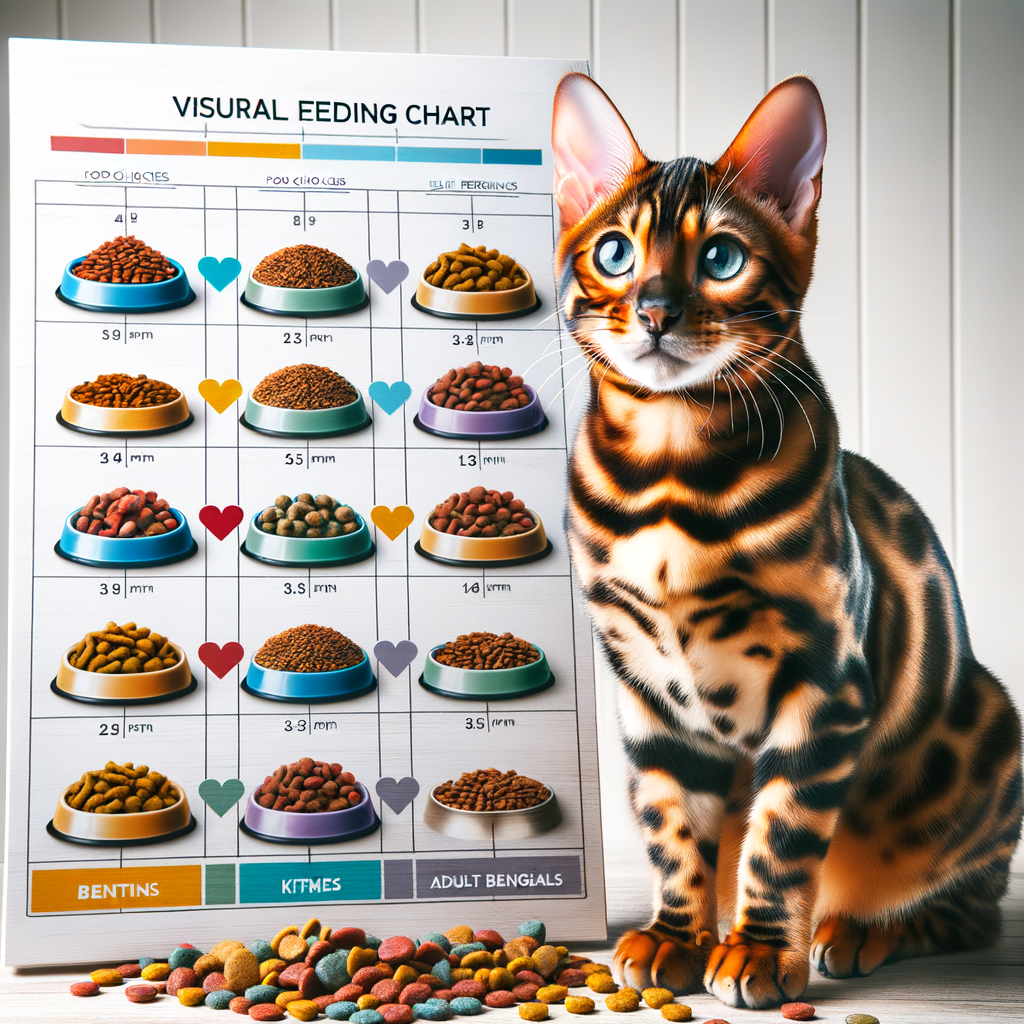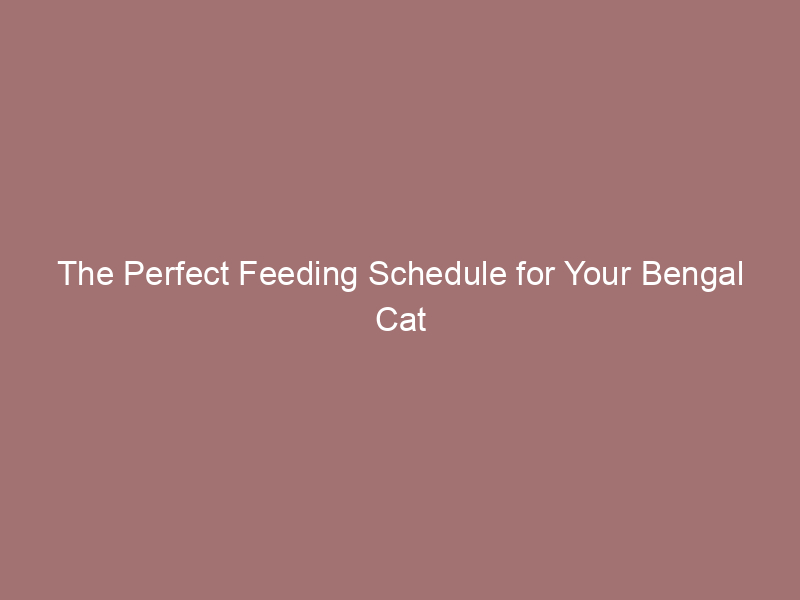
The Best Feeding Schedule for Bengal Cats
-
The Importance of a Feeding Schedule
It helps maintain their health and ensures they get the right nutrients. Regular feeding times can also prevent overeating and obesity.
-
Factors Influencing the Feeding Schedule
Several factors can affect your Bengal cat’s feeding schedule. These include their age, activity level, and health status. Kittens need more frequent meals, while adult cats can eat less often.
Here are some key factors:
- Age: Kittens need to eat more often than adult cats.
- Activity Level: Active cats may need more food.
- Health: Cats with health issues may need special diets.
-
Creating a Bengal Cat Feeding Chart
Creating a feeding chart can help you keep track of your Bengal cat’s meals. This ensures they get the right amount of food at the right times.
Age Meals per Day Portion Size 0-6 months 4-5 Small 6-12 months 3-4 Medium 1 year and older 2-3 Large By following a feeding chart, you can ensure your Bengal cat stays healthy and happy.
Bengal Cat Feeding Schedule
Optimal Feeding Times for Bengal Cats
- Feeding times for kittens:
Bengal kittens need to eat more often than adult cats. They should be fed 4-5 times a day. This helps them grow strong and healthy. Make sure to provide small portions to avoid overeating. - Feeding times for adult cats:
Adult Bengal cats do well with 2-3 meals a day. Feeding them in the morning and evening works best. This routine helps maintain their energy levels throughout the day. - Feeding times for senior cats:
Senior Bengal cats may need more frequent, smaller meals. Feeding them 3-4 times a day can help with digestion and keep their energy up. Adjust the portion sizes based on their activity level and health.
Bengal Cat Diet Plan
How Often to Feed Bengal Cats
- Feeding frequency for kittens: Bengal kittens need more frequent meals. They should be fed 3-4 times a day. This helps them grow strong and healthy.
- Feeding frequency for adult cats: Adult Bengal cats should be fed twice a day. This keeps their energy levels stable and helps maintain a healthy weight.
- Feeding frequency for senior cats: Senior Bengal cats may need smaller, more frequent meals. Feeding them 2-3 times a day can help with digestion and overall health.
Best Food for Bengal Cats
Bengal Cat Nutrition Guide
- Essential nutrients for Bengal catsBengal cats need a balanced diet to stay healthy. Here are some key nutrients they need:
- Protein: Helps build muscles. Look for foods with chicken, fish, or beef.
- Fats: Provides energy. Omega-3 and Omega-6 fatty acids are great for their coat.
- Vitamins and Minerals: Supports overall health. Vitamins A, D, E, and minerals like calcium and phosphorus.
- Taurine: An essential amino acid for heart and eye health.
-
Recommended cat food brands
Choosing the right brand can make a big difference. Here are some top picks:
- Royal Canin: Known for its Bengal-specific formula.
- Blue Buffalo: Offers high-protein options with natural ingredients.
- Hill’s Science Diet: Great for overall health and wellness.
- Wellness CORE: Grain-free and high in protein.
-
Homemade food options
Making food at home can be a good option if done right. Here are some tips:
- Cooked Meat: Chicken, turkey, and fish are good choices. Make sure they are fully cooked and boneless.
- Vegetables: Small amounts of carrots, peas, and spinach can be added.
- Supplements: Add vitamins and minerals to ensure a balanced diet.
- Avoid: Onions, garlic, chocolate, and grapes as they are toxic to cats.
| Essential Nutrient | Importance | Sources |
|---|---|---|
| Protein | Muscle building | Chicken, Fish, Beef |
| Fats | Energy | Omega-3, Omega-6 |
| Vitamins | Overall Health | Vitamins A, D, E |
| Minerals | Bone Health | Calcium, Phosphorus |
| Taurine | Heart and Eye Health | Meat, Fish |
Feeding Tips for Bengal Kittens
- Transitioning from Milk to Solid FoodWhen Bengal kittens are about 4 weeks old, they start to transition from their mother’s milk to solid food. This process is called weaning. Begin by offering wet kitten food mixed with a bit of water or kitten formula. Gradually reduce the amount of liquid until they are eating solid food.
- Portion Sizes for KittensFeed Bengal kittens the right amount of food. Overfeeding can lead to obesity, while underfeeding can stunt their growth. A general guideline is to feed them about 1/4 to 1/2 cup of kitten food per day, divided into several meals. Always check the food packaging for specific recommendations.
- Feeding Frequency and TimesBengal kittens have small stomachs and high energy levels. They need to eat frequently to stay healthy. Feed your kitten 3 to 4 times a day. As they grow older, you can reduce the frequency to 2 to 3 times a day.
Adult Bengal Cat Feeding Routine
Bengal Cat Meal Frequency
- Your cat’s hunger signals: Bengal cats often show they are hungry by meowing, following you, or sitting by their food bowl. Pay attention to these signals to know when it’s time to feed them.
- Adjusting meal frequency based on health and activity level: Active Bengal cats may need more frequent meals. If your cat is very playful or has a high energy level, consider feeding them smaller meals more often. On the other hand, less active cats might do well with fewer meals.
- Preventing overfeeding and obesity: Do not to overfeed your Bengal cat. Obesity can lead to health problems. Measure their food portions and avoid giving too many treats. Regularly check their weight and adjust their diet as needed.
Healthy Diet for Bengal Cats
Bengal Cat Feeding Chart
A proper feeding chart can help you keep track of their meals and make necessary adjustments. Here are some key points to consider:
- Creating a weekly feeding schedule: Plan your Bengal cat’s meals for the week. This helps maintain consistency and ensures they get the right amount of food each day. You can use a simple table like the one below to organize their meals:
| Day | Meal 1 | Meal 2 | Meal 3 |
|---|---|---|---|
| Monday | Wet Food | Dry Food | Treats |
| Tuesday | Wet Food | Dry Food | Treats |
| Wednesday | Wet Food | Dry Food | Treats |
| Thursday | Wet Food | Dry Food | Treats |
| Friday | Wet Food | Dry Food | Treats |
| Saturday | Wet Food | Dry Food | Treats |
| Sunday | Wet Food | Dry Food | Treats |
- Adjusting the diet based on weight and health conditions: If your Bengal cat is overweight or has health issues, you may need to adjust their diet. Consult your vet to determine the best food options and portion sizes. For example, a cat with kidney issues might need a special diet low in phosphorus.
- Monitoring your cat’s health and adjusting the diet accordingly: Keep an eye on your Bengal cat’s weight, coat condition, and energy levels. If you notice any changes, it might be time to adjust their diet. Regular vet check-ups can also help you stay on top of their health needs.






